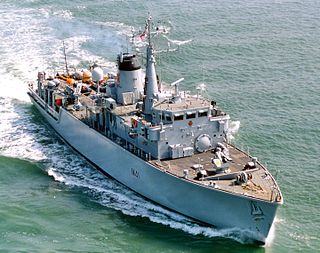
The Hunt class is a class of thirteen mine countermeasure vessels of the Royal Navy. As built, they combined the separate roles of the traditional minesweeper and that of the active minehunter in one hull, but later modifications saw the removal of mine-sweeping equipment. They have a secondary role as offshore patrol vessels.

The Ton class were coastal minesweepers built in the 1950s for the Royal Navy, but also used by other navies such as the South African Navy and the Royal Australian Navy. They were intended to meet the threat of seabed mines laid in shallow coastal waters, rivers, ports and harbours, a task for which the existing ocean-going minesweepers of the Algerine-class were not suited.

The Royal Naval Auxiliary Service (RNXS) was a uniformed, unarmed, civilian volunteer service, administered and trained by the Royal Navy to operate in the ports and anchorages of the United Kingdom in an emergency. Although the abbreviated title would logically have been RNAS this abbreviation had long been taken by the various Royal Naval Air Stations, so RNXS it was. It maintained training units, and vessels at most major ports in the UK. and was formed in 1963 from the amalgamation of the Royal Naval Mine-watching Service (RNMWS) and Admiralty Ferry Crew Association in response to the perceived nuclear threat to British ports. The service was disbanded on 31 March 1994 due to Ministry of Defence (MOD) cuts. Most vessels from its fleet were transferred to the Royal Navy or sold, with the exception of XSV Loyal Volunteer, which was struck by a ro-ro ferry while berthed in Ipswich Harbour and was later scrapped.

The Ham class was a class of inshore minesweepers (IMS), known as the Type 1, of the British Royal Navy. The class was designed to operate in the shallow water of rivers and estuaries. All of the ships in the class are named for British place names that end with -"ham". The parent firm that was responsible for supervising construction was Samuel White of Cowes, Isle of Wight.
HMS Brigham was one of 93 ships of the Ham-class of inshore minesweepers.
HMS Dittisham was one of 93 ships of the Ham-class of inshore minesweepers built for the British Royal Navy. Their names were all chosen from villages ending in -ham. The minesweeper was named after Dittisham in Devon.
HMS Etchingham was one of 93 ships of the Ham-class of inshore minesweepers.

HMS Greetham was one of 93 ships of the Ham class of inshore minesweepers. All ships in this class had names chosen from villages ending in -ham. The minesweeper was built by the firm of Herd & McKenzie in Buckie, Moray and was named after Greetham, Lincolnshire. Entering service in 1955, the vessel was transferred to the Libyan Navy in 1962 on loan and permanently in 1966. Renamed Zuara, the minesweeper was used as a patrol vessel until 1973. Zuara was sold to Captain Morgan Cruises of Malta for commercial use and renamed Lady Davinia. The ship was taken out of service in 2007 and laid up at Sliema Creek. Lady Davinia sank at her moorings in 2008 and for a short time became a diving attraction but in 2011 the wreck was partially broken up after being named a navigational hazard.
HMS Mersham was a Ham-class minesweeper of the Royal Navy. All ships of the class were named after villages ending in -ham. The minesweeper was named after Mersham in Kent. Constructed at Appledore, in Devon, Mersham was launched in April 1954 and completed in January 1955. In April 1955, the ship was transferred to the French Navy and in French service, was known by its pennant number, M773, until it was renamed Violette in 1964. Throughout the 1950s and early 1960s, the vessel undertook minesweeping duties from Brest in Brittany, before being laid up in 1965. In 1974, the ship was transferred to the Gendarmerie and undertook patrol duties until finally being decommissioned in 1987.

HMS Neasham (M2712/IMS49) was a Ham-class minesweeper for the Royal Navy. The names of the Ham-class vessels were all chosen from villages ending in -ham. HMS Neasham was named after Neasham in County Durham.
HMS Petersham was a Ham-class minesweeper of the Royal Navy.
HMS Popham was a Ham-class minesweeper for the Royal Navy.

HMS Portisham was one of 93 ships of the Ham-class of inshore minesweepers.
HMS Powderham was one of 93 ships of the Ham class of inshore minesweepers named after villages ending in -ham, in this case Powderham in Devon. She was launched on 27 November 1958 by J. Samuel White & Company Ltd, Cowes and commissioned in 1959. She was allocated pennant number M 2720.
HMS Puttenham(M2784) was a Ham-class inshore minesweeper of the Royal Navy. She was launched in 1956 and entered service in 1958. The 93 ships of the Ham class had names chosen from villages ending in -ham. The minesweeper was named after Puttenham.
HMS Thornham was one of 93 ships of the Ham-class of inshore minesweepers.

The Echo class was a class of inshore survey vessels built for the British Royal Navy in 1958–1959. The class was designed to operate in close waters such as harbour approaches, shipping lanes, rivers and estuaries. Together, the ships of this class formed the Royal Navy's Inshore Survey Squadron.
Several Royal Navy ships have been named HMS Woodlark or the woodlark:
In 1989 the Royal Navy was under the direction of the Navy Department in the UK Ministry of Defence. It had two main commands, CINCFLEET and Naval Home Command.






